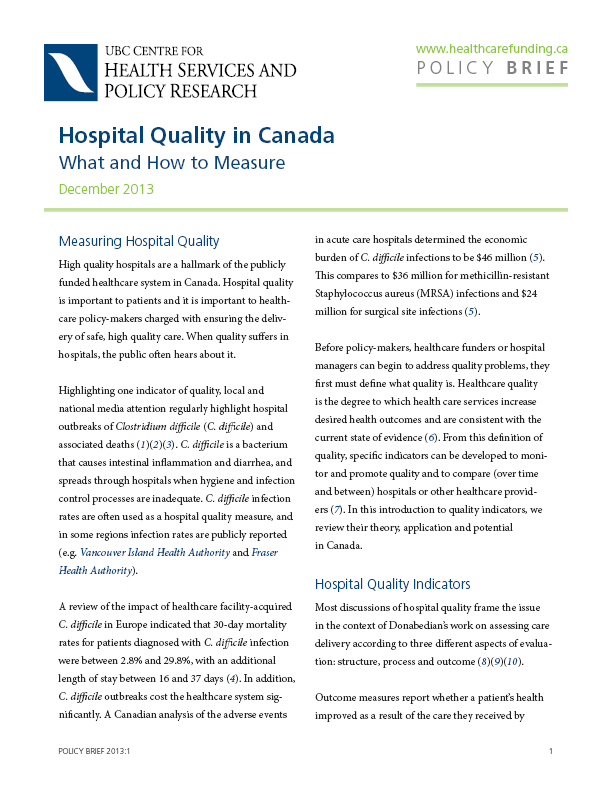The quality of hospital care in Canada is an important issue for both patients and policy-makers. To address healthcare quality problems, quality must first be defined. Healthcare quality is the degree to which health care services increase desired health outcomes and are consistent with evidence-based medicine (Berenholtz, Dorman, Ngo, & Pronovost, 2002). Policy-makers can develop specific indicators to monitor and promote quality and to compare (over time and between) hospitals or other healthcare providers (Copnell et al., 2009). There are three types of indicators used to measure hospital quality (Donabedian, 2005; Evans, Lowinger, Sprivulis, Copnell, & Cameron, 2009; Schuster, McGlynn, & Brook, 2005):
- Structural measures evaluate physical health system characteristics such as infrastructure or nurse staffing levels (Schuster et al., 2005)
- Process measures report interactions between clinicians and patients such as the administration of an intervention
- Outcome measures offer evidence about changes in patients’ health status (Mainz, 2003)
Picking indicators to measure quality is a tricky business. For the overall assessment of hospital quality to be fair, a range of indicators that cover a balance of activities and measures should be used. There is no established best method for selecting indicators, although more comprehensive ones, such as scorecards or composite measures have been developed to try and address the complexity of indicators. These scorecards can sometimes incorporate patient-reported outcome measures (PROMs) or patient-reported experience measures (PREMs).
Some countries have linked funding to quality, in an attempt to provide incentives for improvement. Value-based purchasing (VBP) in the US, which links hospital remuneration to the delivery of high quality care, is one example (Damberg et al., 2007). Some countries, like the UK and Germany, use negative incentives to improve quality, such as not paying hospitals for unplanned readmissions (Busse et al., 2013).
The Canadian Institutes of Health Information (CIHI) reports a number of hospital quality indicators. In 2013, CBC created a controversial national hospital performance report card that ranked 239 hospitals using CIHI data.
Funding policies that link money to hospital quality are becoming more and more popular, despite the limited evidence that these programs are effective at actually increasing quality. Reporting on quality in healthcare is reasonably widespread internationally, though less so in Canada, but no consensus exists on the best method for measuring healthcare quality, nor on how to best use information on quality to inform the public.
For more a more detailed look at measuring hospital quality, indicator selection, detailed examples and links to organizations that have created quality indicators, please download our policy brief.

